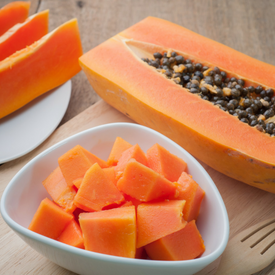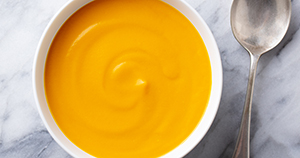Papaya

The papaya (also known as the Paw Paw in Australia, or the Mamao in Brazil), is believed to be native to southern Mexico and neighboring Central America. It was spread to the south by Indians, and throughout the Caribbean with Spanish exploration. The Spanish also carried it to Europe and the Pacific Islands.
Papaya was introduced to Hawaii in the 1800s, and Hawaii remains the only state in the USA to produce papaya commercially. Papayas are very susceptible to the ringspot virus. In fact, in the1990’s it nearly wiped out Hawaii’s crop. Scientists introduced a genetic modification to the seeds, and saved the papaya business in Hawaii. This example of genetic engineering also made the papaya the first genetically modified fruit crop used for human consumption.
The papaya is a pear-shaped fruit with a bright golden-yellow skin. The yellow-orange flesh is juicy and silky smooth, with a sweet-tart flavor. Papayas are low in calories and sodium and are excellent source of vitamin A and C, and potassium. There are also small amounts of calcium, iron, thiamine, riboflavin and niacin present in papaya. They contain a lot of water, making them a great thirst-quenching snack when playing sports or other outdoor activities.
Papayas contain a digestive enzyme that is used to tenderize meat. This enzyme, papain, is commercially harvested in large quantities from the skin and green fruit. but papaya juice has been used for centuries in South America to tenderize meat.
At the market
Papaya is available in most supermarkets all year round. If you plan to eat them right away, look for fruit that’s mostly yellow in color and slightly soft to the touch. Papayas that are mostly green with a bit of yellow color, and firm, will be ready to eat in a few days. Avoid fruits with too many black marks or soft spots.
There are two types of papayas, Hawaiian and Mexican. The Hawaiian type weigh about 1 pound and have yellow skin when ripe. Mexican papayas may weigh up to 10 pounds and be more than 15 inches long. Hawaiian papayas have a little more intense flavor than the Mexican variety. Both are delicious and extremely enjoyable.
Storage
Slightly green papayas will ripen quickly at room temperature. Place them in a brown paper bag at room temperature if you wish to accelerate the ripening process. If completely ripe, refrigerate, in the crisper, and use as soon as possible.
Preparation
A papaya has the consistency of a melon with a combination sweet & tart flavor. To prepare a papaya for eating or cooking, cut it in half and scoop out the seeds with a spoon. Next use a vegetable peeler to remove the skin. The fruit is is now ready to slice, dice, or eat.
Papaya seeds are edible (they are spicy like black pepper), but they are usually discarded. Some chefs add the seeds to salad dressings. If you like the spicy flavor of pepper, we encourage you give the seeds a try.
To boost the natural flavor, sprinkle papaya with lemon or lime juice.

Papaya Summer Soup
Cold, fruit soups may seem a bit sophisticated for a toddler, but think again. They are perfect – sweet, healthy, and refreshing. Come to think of it, they are perfect for anyone on a hot summer day. Bring two spoons to the table with a bowl of this soup. Better yet, bring a second bowl – toddlers aren’t much for sharing. Enjoy!
- 1 papaya peeled, seeded, and cut into chunks
- ½ cup pineapple, cut into chunks
- 1 1/2 cups of vanilla yogurt (soy or dairy)
- 1/2 cup of milk (soy of dairy)
- 1 Tbsp. honey
- 2 tsp. lime juice
- Sprinkle of nutmeg and cinnamon
Directions: Puree all ingredients in a blender. Chill and serve.
Easy ideas for adding tropical papaya flavor to your meals
Tropical Side Salad: In a salad bowl add 1 diced papaya, 1 diced mango, 1 diced cucumber and ¼ cup finely diced red onion, 2 Tablespoons chopped cilantro and 1-1/2 cups of cooked white rice. For the dressing, whisk together in a small bowl, ¼ cup olive oil, 2 Tablespoons rice vinegar, 2 tablespoons fish sauce, 1 Tablespoon lime juice, 1-2 Tablespoons honey (to taste) and 2 garlic cloves minced. Pour dressing over salad and toss gently, and garnish with chopped peanuts.
Simple Thai-spiced Shrimp and Papaya: Sauté 1 pound of raw, peeled shrimp and 1 peeled and sliced papaya in 2 Tablespoons of olive oil over medium heat. When shrimp are pink remove fruit and shrimp from pan. Set aside. To the hot pan, Add one can of coconut milk, 1-2 teaspoons red curry paste, 2 Tablespoons fish sauce, 1 Tablespoon lime juice. Heat the sauce gently over medium-low heat until bubbling. Add shrimp and papaya back to the pan to warm. Garnish with chopped cilantro. Serve with rice.
Papaya Bed for Kabobs or Grilled Meats/Tofu: Next time you are grilling, add the WOW factor to the presentation and add a new flavor. Simply slice papayas and line a serving platter with them. Sprinkle the slices with lime juice. When you are done grilling, place the main dish right on top of the papaya slices and serve. It will be a hit!
Papaya Salsa: We love to use fresh salsas to change up the flavor of foods. Salsa takes a plain baked or grilled item from bland to gourmet with only minutes of prep work and no cooking. Salsas are also a simple way to add an extra fruit or veggie serving to your meal. Try this papaya salsa with grilled fish.
Ingredients:
- 1 papaya, seeded, peeled and diced
- 1/2 cup diced fresh pineapple
- 2 green onions, finely chopped
- 1 small garlic clove, minced
- 2 tablespoons chopped fresh mint
- 1 Tablespoon lime juice
- 1 Tablespoon olive oil
- Salt and pepper, to taste
Directions: In a bowl, combine all ingredients and set aside at room temperature until ready to serve.








